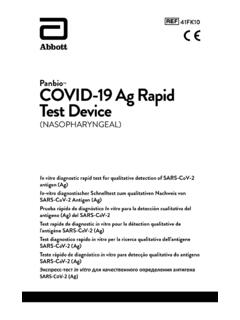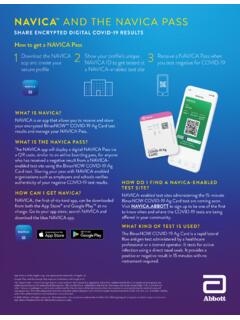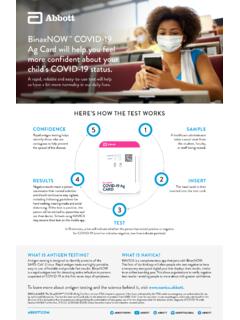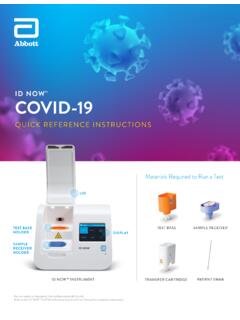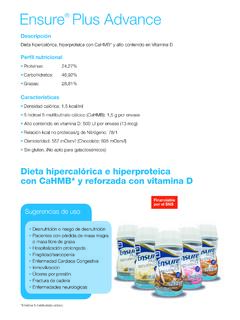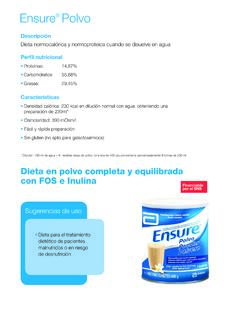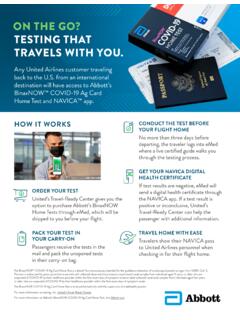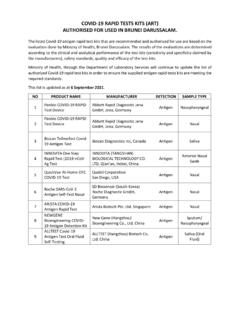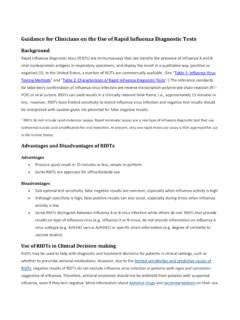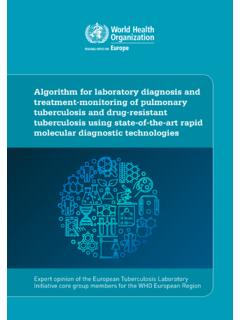Transcription of Panbio COVID-19 Ag Rapid Test Device - Abbott Laboratories
1 41FK11/41FK21. Panbio . COVID-19 Ag Rapid Test Device (NASAL). In vitro diagnostic Rapid test for qualitative detection of SARS-CoV-2. antigen (Ag). About the Test EN. Introduction The Coronavirus disease ( COVID-19 ) is an infectious disease caused by a newly discovered coronavirus, severe acute respiratory syndrome coronavirus 2. (SARS-CoV-2)1. The SARS-CoV-2 is a -coronavirus, which is an enveloped non-segmented positive-sense RNA virus2. It is spread by human-to-human transmission via droplets or direct contact, and infection has been estimated to have a mean incubation period of days and a basic reproduction number of Among patients with pneumonia caused by SARS-CoV-2, fever was the most common symptom, followed by cough3.
2 The main IVD assays used for COVID-19 employ real-time reverse transcriptase-polymerase chain reaction (RT-PCR) that takes a few hours4. The availability of a cost-effective, Rapid point- of-care diagnostic test is critical to enable healthcare professionals to aid in the diagnosis of patients and prevent further spread of the virus5. Antigen tests will play a critical role in the fight against covid -196. Test Principle Panbio COVID-19 Ag Rapid Test Device contains a membrane strip, which is pre-coated with immobilized anti-SARS-CoV-2 antibody on the test line and mouse monoclonal anti-chicken IgY on the control line.
3 Two types of conjugates (human IgG specific to SARS-CoV-2 Ag gold conjugate (binds to the nucleocapsid protein) and chicken IgY gold conjugate) move upward on the membrane chromatographically and react with anti-SARS-CoV-2 antibody and pre-coated mouse monoclonal anti-chicken IgY respectively. For a positive result, human IgG. specific to SARS-CoV-2 Ag gold conjugate and anti-SARS-CoV-2 antibody will form a test line in the result window. Neither the test line nor the control line are visible in the result window prior to applying the patient specimen. A visible control line is required to indicate a test result is valid.
4 Intended Use Panbio COVID-19 Ag Rapid Test Device is an in vitro diagnostic Rapid test for the qualitative detection of SARS-CoV-2 antigen (Ag) in human nasal swab specimens from individuals who meet COVID-19 clinical and / or epidemiological criteria. Panbio COVID-19 Ag Rapid Test Device is for professional use only and is intended to be used as an aid in the diagnosis of SARS-CoV-2 infection. The product may be used in any laboratory and non-laboratory environment that meets the requirements specified in the Instructions for Use and local regulation. The test provides preliminary test results.
5 Negative results don't preclude SARS- CoV-2 infection and they cannot be used as the sole basis for treatment or other management decisions. Negative results must be combined with clinical ENGLISH. observations, patient history, and epidemiological information. The test is not intended to be used as a donor screening test for SARS-CoV-2. - 1 - Kit Variants 41FK11 No 2D barcode printed on the contained test devices 41FK21 Contains test devices with a 2D barcode printed on the test Device , which encodes traceability information for the product Materials Provided 25 Test devices with desiccant in individual foil pouch Buffer (1 x 9 ml/bottle).
6 25 Extraction tubes 25 Extraction tube caps 1 Positive control swab 1 Negative control swab 25 Sterilized nasal swabs for sample collection 1 Tube rack 1 Quick Reference Guide 1 Instructions for use Materials Required but not Provided Personal Protective Equipment per local recommendations ( gown/. lab coat, face mask, face shield/eye goggles and gloves), Timer, Biohazard container Active Ingredients of Main Components 1 Test Device Gold conjugate: Human IgG specific to SARS-CoV-2 Ag gold colloid and Chicken IgY - gold colloid, Test line: Mouse monoclonal anti- SARS-CoV-2, Control line: Mouse monoclonal anti-Chicken IgY.
7 Buffer Tricine, Sodium Chloride, Tween 20, Sodium Azide (< ), Proclin 300. Storage and Stability 1. The test kit should be stored at a temperature between 2-30 C. Do not freeze the kit or its components. Note: When stored in a refrigerator, all kit components must be brought to room temperature (15-30 C) for a minimum of 30 minutes prior to performing the test. Do not open the pouch while components come to room temperature. 2. The Buffer bottle may be opened and resealed for each assay. The Buffer cap should be firmly sealed between each use. The Buffer is stable until expiration date if kept at 2-30 C.
8 ENGLISH. 3. Perform the test immediately after removing the test Device from the foil pouch. 4. Do not use the test kit beyond its expiration date. - 2 - 5. The shelf life of the kit is as indicated on the outer package. 6. Do not use the test kit if the pouch is damaged or the seal is broken. 7. Direct swab specimens should be tested immediately after collection. If immediate testing is not possible, the swab specimen can be kept in an extraction tube filled with extraction buffer (300 l) at room temperature (15-30 C) for up to two hours prior to testing.
9 Warnings 1. For in vitro diagnostic use only. Do not reuse the test Device and kit components. 2. These instructions must be strictly followed by a trained healthcare professional to achieve accurate results. All users have to read the instruction prior to performing a test. 3. Do not eat or smoke while handling specimens. 4. Wear protective gloves while handling specimens and wash hands thoroughly afterwards. 5. Avoid splashing or aerosol formation of specimen and buffer. 6. Clean up spills thoroughly using an appropriate disinfectant. 7. Decontaminate and dispose of all specimens, reaction kits and potentially contaminated materials ( swab, extraction tube, test Device ) in a biohazard container as if they were infectious waste and dispose according to applicable local regulations.
10 8. Do not mix or interchange different specimens. 9. Do not mix reagent of different lots or those for other products. 10. Do not store the test kit in direct sunlight. 11. To avoid contamination, do not touch the head of provided swab when opening the swab pouch. 12. The sterilized swabs should be used only for nasal specimen collection. 13. To avoid cross-contamination, do not reuse the sterilized swabs for specimen collection. 14. Do not dilute the collected swab with any solution except for the provided extraction buffer. 15. The buffer contains < sodium azide as a preservative which may be toxic if ingested.
